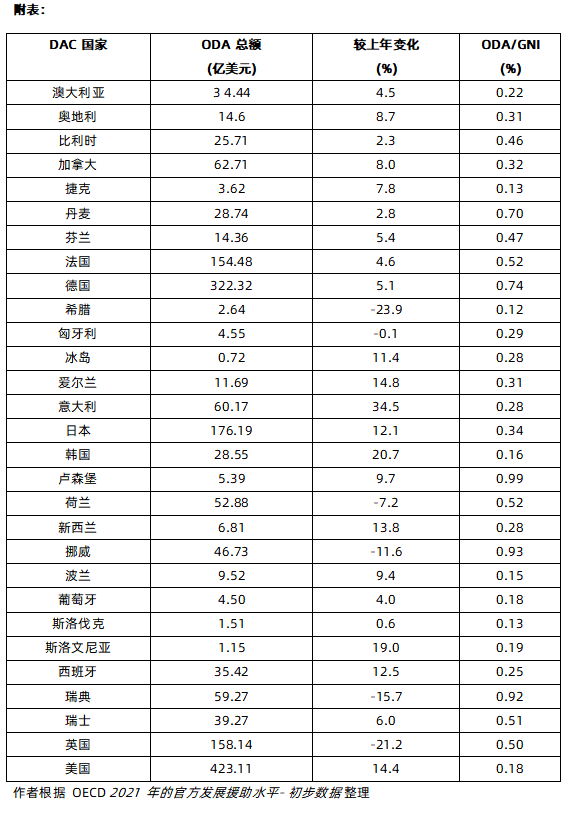Author: Julia Sun
Preliminary data shows that donor countries’ official development assistance (ODA) regulations in 2021The model set a new record of US$179 billion.
Total words1445About2minutes
On April 12, the Development Assistance Committee of the Organization for Economic Cooperation and Development (OECD DAC) released preliminary statistics on official development assistance (ODA) in 2021. Data show that the scale of development assistance from DAC member countries in 2021 continued to grow based on 2020 and set a new record of US$179 billion. In 2021, total development assistance increased by 4.4% compared with the previous year, which is equivalent to 0.33% of the gross national income (GNI) of DAC member states, which is the same as in 2020, but is still lower than the United Nations’ target of ODA accounting for 0.7% of gross national income. . DAC will release final data on official and private financial flows to developing countries in December 2022.

Which countries are the main sources of aid growth?
In 2021, the United States remained the largest DAC donor, with total official development assistance reaching $42.3 billion. Germany ranked second with $32.2 billion. Japan, the United Kingdom, and France followed closely, donating US$17.6 billion, US$15.8 billion, and US$15.4 billion respectively. The official development assistance provided by the G7 and EU countries accounted for 76% and 45% of the total official development assistance respectively.
Actual aid increased in 23 of the 29 DAC member countries. Aid from Italy, the United States and Japan increased by 34.5%, 14.4% and 12.1% respectively. South Korea, Slovenia, Ireland, New Zealand, Spain and Iceland also saw aid increases exceeding 10%. These increases offset UK aid cuts of up to 21%.
Which countries’ official development assistance reaches 0.7%?
In 2021, the official development assistance of five DAC member states reached or even exceeded the target of 0.7%, namely Denmark (0.70%), Germany (0.74%), Luxembourg (0.99%), Norway (0.93%) and Sweden (0.921 TP3T). In addition, the proportion of official development assistance of 7 member countries ranges from 0.33% to 0.7%, and the proportion of official development assistance of 17 member countries is less than the average level of 0.33%.
In addition to DAC members, other donor countries also have a long tradition of development cooperation. Some donor countries that are not members of the DAC cooperate with the OECD to share official development assistance data. Preliminary statistics show that in 2021, Turkey's official development assistance accounted for 0.95% of gross national income, exceeding the United Nations target of 0.7%.
What key areas will official development assistance flow to in 2021?
The proportion of aid related to the new crown epidemic is as high as 10%.Preliminary estimates show that in 2021, US$18.7 billion in official development assistance will be used for COVID-19 related activities, accounting for 10.5% of total net official development assistance. Among them, US$11 billion is used for prevention, treatment and care, as well as vaccine donation and other support related to the prevention and control of the new crown epidemic. EU institutions have donated US$10.5 billion to support developing countries in coping with the consequences of the pandemic, of which US$1.3 billion has been allocated to COVID-19 control.
The proportion of refugee expenses in donor countries is about 5%.In 2021, US$9.3 billion in official development assistance was used for refugee-related costs incurred in donor countries, accounting for 5.2% of total development assistance. According to relevant OECD regulations, within 12 months of the arrival of refugees and asylum seekers from developing countries in the donor country, the costs related to the basic services provided by the donor country can be included in ODA expenditures. In real terms, the refugee costs of donor countries are almost unchanged compared to 2020, but compared with the peak of 11% in 2016, the cost ratio has almost halved.
Other bilateral official development assistance fell by 3.3%.In 2021, excluding assistance related to refugees and vaccine donations in donor countries, other bilateral official development assistance for projects and technical assistance fell by 3.3%. Part of this is due to a decline in bilateral sovereign ODA lending. Preliminary statistics show that grant-equivalent bilateral sovereign loans fell by 4.6%. In 2021, DAC country grant-equivalent bilateral sovereign loans accounted for 10% of bilateral official development assistance. Countries with a high proportion of sovereign loans in bilateral ODA include France (23%), Japan (55%) and South Korea (36%).
The preliminary data on official development assistance in 2021 are based on the responses to the preliminary questionnaire from OECD DAC member countries, and mainly involve the total official development assistance of each country.

All rights reserved, please indicate the source when citing.

References
https://www.oecd.org/dac/financing-sustainable-development/refugee-costs-oda.htm

